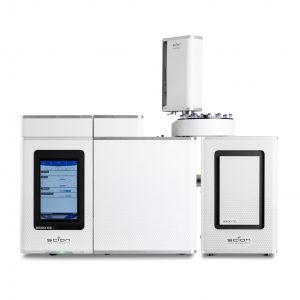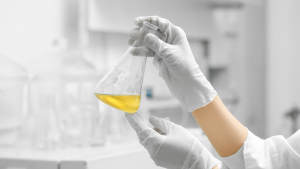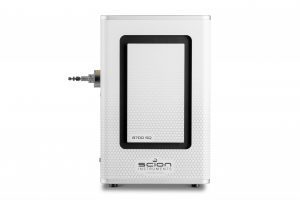The Different Types of GC Detectors
GC Detector Guide – The Types and Their Differences
A detector serves as an essential analytical instrument in gas chromatography for the identification of sample compounds as they elute from the chromatography column. Various detection techniques are employed in this context, including:
- Flame ionization
- Thermal conductivity
- Electron capture
- Nitrogen phosphorous
- Pulsed flame photometric
- Mass spectrometry
- Pulsed discharge helium ionization
Detectors play a pivotal role within the GC setup. They are responsible for converting and presenting the data collected during the GC analysis into a user-friendly format for the technician. This data is then able to be archived and subject to further analysis.

Broadly, GC detectors fall into two main categories: destructive and non-destructive. Destructive detectors, such as flame ionization, alter the column effluent through processes like combustion or mixing, rendering compound recovery challenging. On the other hand, non-destructive detectors, like thermal conductivity, directly measure the properties of eluent. The use of non-destructive detectors simplifies and enhances compound recovery, making it a more efficient and effective process.
Flame Ionization Detector – What is GC-FID?
Gas Chromatography-Flame Ionization Detection (GC-FID) is an analytical method employed for the separation and analysis of mixtures containing volatile components. Among the various gas chromatography detectors, the flame ionization detector (FID) stands as one of the most widely used due to its reputation for reliability and sensitivity.
GC-FID applications include:
- Quantification of Organic Compounds: GC-FID proves invaluable in the detection and quantification of organic compounds such as fatty acids in food.
- Industry and Research: It finds extensive application in both industrial processes and research endeavours for the characterising complex mixtures of organic compounds
- Pharmaceutical Analysis: Within the pharmaceutical sector, this method is employed to identify residual contaminants, ensuring the quality and safety of pharmaceutical products
- Petrochemical Analysis: GC-FID is instrumental for detecting and quantifying various hydrocarbon elements present in oil and other fuels.
- Environmental Research: Researchers use this technique to detect resin acids in water samples and identify toxins in air samples, contributing to environmental monitoring and protection efforts.

A gas chromatography flame ionization detector is composed of an air or hydrogen flame and a collector plate. As the sample reaches the end of the chromatography column, it enters the flame-ionization chamber, where it combines with hydrogen and a suitable oxidant. The flame ionization detector operates by subjecting the analyte to a hydrogen flame, leading to the breakdown of organic molecules and the ionization of chemical components, giving them a positive charge. These ions are subsequently gathered on the collector plate, where their presence generates an electric current upon contact. The magnitude of this electric current is directly proportional to the number of carbon atoms combusted. By employing certified analytical reference standards, it is possible to record and analyze the data to determine the composition and respective quantities of the components within the original sample.
FID is arguably the most popular gas chromatography detector, due to its unwavering reliability and sensitivity, particularly in the detection of organic vapours.
Thermal Conductivity Detector – What is GC-TCD?
Thermal Conductivity Detectors, also known as Katharometers, play a crucial role in gas chromatography. These detectors have the ability to sense changes in the thermal conductivity of the carrier gas when analyte molecules are present in the gas stream. A thermal conductivity detector in gas chromatography is commonly chosen as the preferred method when extreme sensitivity is not the primary requirement.
A TCD consists of a heated filament, where variations in filament current occur as the carrier gas, containing solutes, passes through the cell. During the gas chromatography process, a gas sample is introduced and separated based on its chemical properties. The TCD incorporates parallel paths for the carrier gas flow, which are separated by a thermal conductivity cell containing a heated filament. The carrier gas flows over this filament, maintaining a constant electrical current. Changes in electrical resistance and current occur when the analyte-containing gas disrupts the filament’s heat transfer. The extent of this current change is directly proportional to the concentration of the analyte, which is then recorded and quantified by the gas chromatography instrument.
Nitrogen Phosphorous Detector – What is GC-NPD?
A nitrogen phosphorous detector (NPD) is employed in conjunction with gas chromatography for the analysis of organic compounds consisting of nitrogen or phosphorous. The NPD operates on a principle similar to that of a flame ionization detector (FID), utilizing a hydrogen/air flame. It does however have a reduced flow rate to prevent the formation of a flame at the tip f the jet, while enabling the creation of a cold plasma.
In contrast to the FID, which employs a polarization electrode, the NPD is equipped with a bead made of rubidium or alkali caesium chloride, positioned within an array of silica located between the nozzle and the polarization electrode. The electronic configuration of the NPD closely resembles that of the FID, featuring a cylindrical anode at a positive potential relative to the jet and the bead. Notably, unlike the FID, the NPD does not necessitate a separate makeup flow although some instruments may offer this option.
Electron Capture Detector – What is GC-ECD?
An electron capture detector (ECD) is used for the detection of gas molecules by capturing electrons and measuring the resulting charge in current within the detector chamber. Each chemical species exhibits different degrees of electron absorptions, leading to a fall in the current. This reduction allows for the identification of present compound and their respective concentrations.

ECDs boast sensitivity levels up to 1000 times higher than FIDs and were the inaugural detectors capable of quantifying components at parts-per-billion (ppb) and parts-per-trillion (ppt) levels. This exceptional sensitivity renders electron capture detectors the preferred choice for environmental assessments.
GC-ECD is frequently employed in environmental testing and food analysis to test for the presence of organochlorine pesticides and potentially harmful polychlorinated biphenyl compounds (PCBs).
Pulsed Flame Photometric Detector – What is GC-PFPD?
A Pulse Flame Photometric Detector (PFPD) stands out as an exceptionally selective elemental sensor, proficient in analyzing a wide range of elements. However, it is predominantly employed for the analysis of sulfur, phosphorus, and organic nitrogen. Differing from a Flame Photometric Detector (FPD), Pulse Flame Photometric Detectors were designed to tackle issues related to sensitivity and selectivity within the FPD.
The innovation of the pulse flame mechanism enhances both sensitivity and selectivity through a combination of temporal resolutions. This is achieved by employing timed electronic integration of the emission signal, thereby improving selectivity. Additionally, optical resolution is enhanced through the utilization of a wider-band pass filter and distinct photomultipliers, thereby boosting sensitivity.
The PFPD offers several notable advantages over the conventional FPD, including:
- Higher sensitivity, typically ranging from 10 to 100 times that of the FPD.
- Enhanced selectivity, with an improvement of at least tenfold compared to the FPD.
- A direct and equimolar response for sulfur and phosphorus, facilitating simpler calibrations.
- Reduced gas requirements.
- Minimum maintenance demands.
The unique operation of the PFPD makes it suitable for numerous applications that surpass the abilities and bounds of a flame photometric detector. Notable application areas include pesticide testing, petrochemicals, flavour and fragrance analysis, chemical agent examination, and food and beverage quality control.
Mass Spectrometry – What is GC-MS?
Gas Chromatography Mass Spectrometry (GC-MS) is a comprehensive analytical technique that merges two fundamental methods: gas chromatography (GC) and mass spectrometry (MS). Its primary purpose is the identification of various substances and the assessment of chemical concentrations within a given sample. A mass spectrometer is an instrumental device designed to recognize and quantify the vaporized compounds derived from GC separation. While gas chromatography supplies data related to retention time and peak intensity, mass spectrometry enriches this information by introducing a third dimension involving mass measurements.
The mass data obtained is pivotal for a variety of applications, including the identification, quantification, and determination of the structural and chemical attributes of molecules. GC-MS analysis commences with the vaporization of the sample within the GC, transitioning it into a gaseous phase and subsequently dividing it into its constituent components. As these components exit the GC column, they undergo ionization and fragmentation within the mass spectrometer, facilitated by electron ionization sources.

By applying an electrical charge to the filament, it releases a flow of electrons towards incoming compounds, causing them to fragment, many acquiring a positive charge. The distinctive pattern of subsequent fragments serves as a detailed “fingerprint” for chemical identification. These fragments subsequently pass through the mass analyzer, where they are separated according to their unique mass-to-charge (m/z) ratios.
There are some additional types of mass spectrometers which may be required based on specific detection needs, depending on the requisite levels of selectivity and sensitivity. Examples of these different types include single quad and triple quad mass spectrometers.
Pulsed Discharge Helium Ionization Detector – What is GC-PDHID?
A Pulsed Discharge Helium Ionization Detector, referred to as a PDHID, is a variant of Pulsed Discharge Detection (PDD). It employs a direct current or glow discharge to identify compounds that have been separated through a chromatographic process. PDD, as a non-invasive detection method, offers a choice between two operational modes: electron capture mode or helium photoionization mode. SCION specializes in the utilization of helium photoionization in PDD. This specific mode, known as pulsed discharge helium ionization detection (PDHID), provides remarkable sensitivity.
When the PDHID is employed as a detection technique in a parallel column setup, it enables the analysis of permanent gases and carbon dioxide down to an exceptionally low detection limit (LDL) of approximately 50 parts per billion (ppb) within 120 seconds. This makes it a highly efficient option for industries where Flame Ionization Detectors (FID) pose risks or are inappropriate, such as in petrochemical plants and oil refineries. In such cases, a PDHID serves as a great substitute.
Get In Touch
For more information about our GC Detectors, please get in touch.
